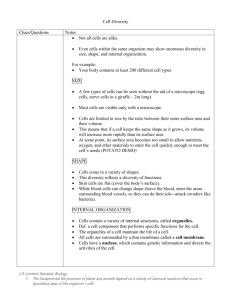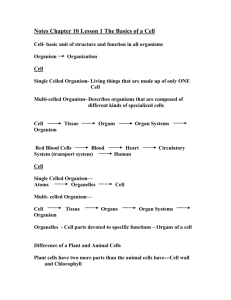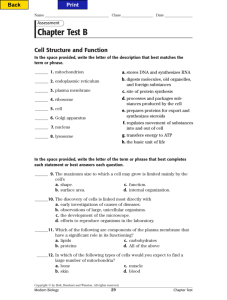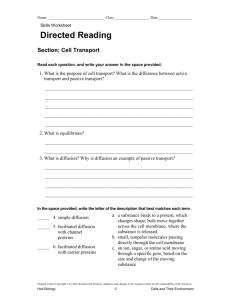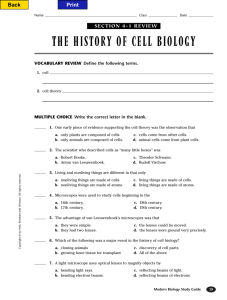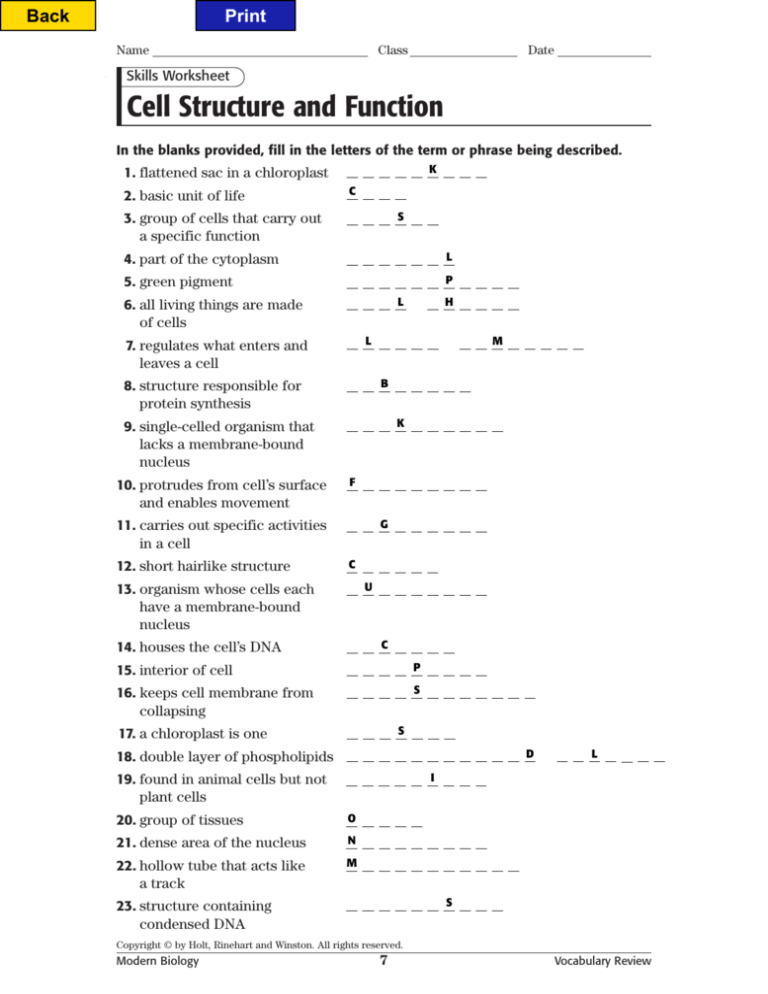
Back
Print
Name
Class
Date
Skills Worksheet
Cell Structure and Function
In the blanks provided, fill in the letters of the term or phrase being described.
K
1. flattened sac in a chloroplast
2. basic unit of life
C
S
3. group of cells that carry out
a specific function
4. part of the cytoplasm
L
5. green pigment
P
L
6. all living things are made
of cells
L
7. regulates what enters and
leaves a cell
M
B
8. structure responsible for
protein synthesis
K
9. single-celled organism that
lacks a membrane-bound
nucleus
10. protrudes from cell’s surface
and enables movement
F
G
11. carries out specific activities
in a cell
12. short hairlike structure
H
C
U
13. organism whose cells each
have a membrane-bound
nucleus
C
14. houses the cell’s DNA
15. interior of cell
P
16. keeps cell membrane from
collapsing
S
S
17. a chloroplast is one
D
18. double layer of phospholipids
L
I
19. found in animal cells but not
plant cells
20. group of tissues
O
21. dense area of the nucleus
N
22. hollow tube that acts like
a track
M
S
23. structure containing
condensed DNA
Copyright © by Holt, Rinehart and Winston. All rights reserved.
Modern Biology
7
Vocabulary Review
Back
Print
Name
Class
Date
Cell Structure and Function continued
Complete each statement by writing the correct term or phrase in the space
provided.
24. The
is an extensive system
of internal membranes that move proteins and other substances through
the cell.
25. The
is the jellylike liquid in the nucleus.
26. The
distribution center of the cell.
is the packaging and
27. The organelles that contain the cell’s digestive enzymes are
.
28. The organelles that transfer energy from organic compounds to ATP
are
.
29. Organelles that use light energy to make carbohydrates from carbon dioxide
and water are
.
30. The
stores water and may
contain many substances, such as enzymes, water, and wastes.
31. The cell membrane of a plant is surrounded by a thick
, which supports
and protects the cell.
32. A(n)
is a collection of
identical cells that live together in a connected group.
33. The
that is covered with pores.
is a double membrane
34. Long threads made of actin are called
.
35. The size of a cell is limited by its
-
-
-
.
36. A(n)
that perform related tasks.
is a group of organs
Copyright © by Holt, Rinehart and Winston. All rights reserved.
Modern Biology
8
Vocabulary Review
Back
Print PAGE
TEACHER RESOURCE
16. A peptide bond is the covalent bond
17.
18.
19.
20.
21.
that links two amino acids. A polypeptide is a long chain of amino acids
linked together by peptide bonds.
A fatty acid is an unbranched carbon
chain that makes up most lipids. Most
lipids are composed of fatty acids.
An enzyme is a substance that speeds
up chemical reactions. An active site is
the location on an enzyme that binds
to a substrate.
A monosaccharide is a monomer of a
carbohydrate. A disaccharide is a carbohydrate made of two monosaccharides linked together.
DNA is a nucleic acid that stores
hereditary information used to make
proteins. RNA is a nucleic acid that is
involved in protein synthesis.
ATP is an organic molecule that acts
as the main energy currency of cells.
Carbohydrates are organic molecules
that act as a source of energy in cells.
Cell Structure and Function
1.
2.
3.
4.
5.
6.
7.
8.
9.
10.
11.
12.
13.
14.
15.
16.
17.
18.
19.
20.
21.
22.
23.
24.
25.
26.
27.
28.
THYLAKOID
CELL
TISSUE
CYTOSOL
CHLOROPHYLL
CELL THEORY
PLASMA MEMBRANE
RIBOSOME
PROKARYOTE
FLAGELLUM
ORGANELLE
CILIUM
EUKARYOTE
NUCLEUS
CYTOPLASM
CYTOSKELETON
PLASTID
PHOSPHOLIPID BILAYER
CENTRIOLE
ORGAN
NUCLEOLUS
MICROTUBULE
CHROMOSOME
endoplasmic reticulum
nucleoplasm
Golgi apparatus
lysosomes
mitochondria
29.
30.
31.
32.
33.
34.
35.
36.
chloroplasts
central vacuole
cell wall
colonial organism
nuclear envelope
microfilaments
surface-area-to-volume ratio
organ system
Homeostasis and Cell
Transport
1.
2.
3.
4.
5.
6.
7.
8.
9.
h
j
i
a
k
b
p
n
f
10.
11.
12.
13.
14.
15.
16.
17.
e
m
o
d
g
c
q
l
Photosynthesis
1.
2.
3.
4.
5.
6.
7.
8.
9.
10.
11.
12.
13.
14.
15.
16.
photosynthesis
autotrophs
heterotrophs
granium
pigment
chlorophyll
carotenoids
electron transport chain
carbon fixation
Calvin cycle
C4 pathway
CAM pathway
chemiosmosis
light reactions
stomata
thylakoids
Cellular Respiration
1.
2.
3.
4.
5.
6.
7.
8.
9.
10.
11.
alcoholic fermentation
pyruvic acid
acetyl CoA
aerobic respiration
anaerobic
NADH
oxaloacetic acid
citric acid
NAD+
cellular respiration
mitochondrial matrix
Copyright © by Holt, Rinehart and Winston. All rights reserved.
Modern Biology
104
Answer Key


